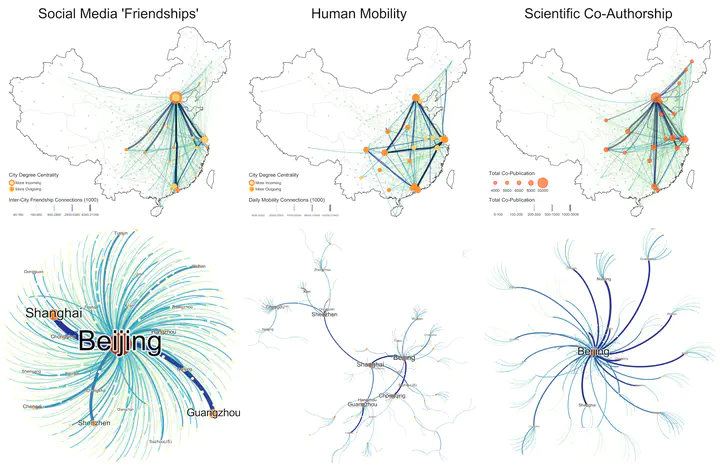Intercity Connectivity and Innovation
 Three intercity networks at China
Three intercity networks at ChinaThis work is completed with Dr. César A. Hidalgo, Dr. Pierre-Alexandre Balland, Dr. Siqi Zheng, and Dr. Jianghao Wang.
View intercity connectivity interactive data dashboard HERE.
View and download intercity connectivity dataset HERE.
See published manuscript HERE
Methods and Insights
We measured intercity connectivity with three networks (social media, mobility, and intercity connectivity) for the two largest economies, China and the US. Then we incorporated network metrics and cities’ population, GDP, and education into scaling models to explore the variances – differences in innovation for cities with similar characteristics.
We found that when incorporating intercity connectivity inputs, scaling models are more powerful at predicting patents, especially for more complex patents. The results are more robust for China, after controlling for population, GDP, and education, than for the U.S. We also found that social media and mobility intercity connectivity help explain the variance in city-wide patent outputs in China, while scientific collaboration plays a more significant role in the U.S.
What this means is that while big cities have advantages in producing complex patents due to their dominant positions in multiple networks, small cities may catch up if they improve their intercity connectivity. Causal relationships need to be further tested. Still, the correlation poses interesting questions about the future of cities marginalized/outperforming in intercity networks, such as small cities dedicated to tourism (for enhanced mobility flows) and digital nomads (for enhanced digital connectivity), or those fly-over towns that are losing tractions in both population and ideas alike.
This paper also attempts to bring two separate conversations together – one in scaling literature which usually discusses the return of scale in innovation solely based on population, and the other in regional science, which often uses regression models to examine relationships between various regional characteristics and innovation. This in-between position of the paper is uncomfortable to grapple with (which is reflected in our review process) but valuable to reflect on the theoretical basis to understand regional issues.